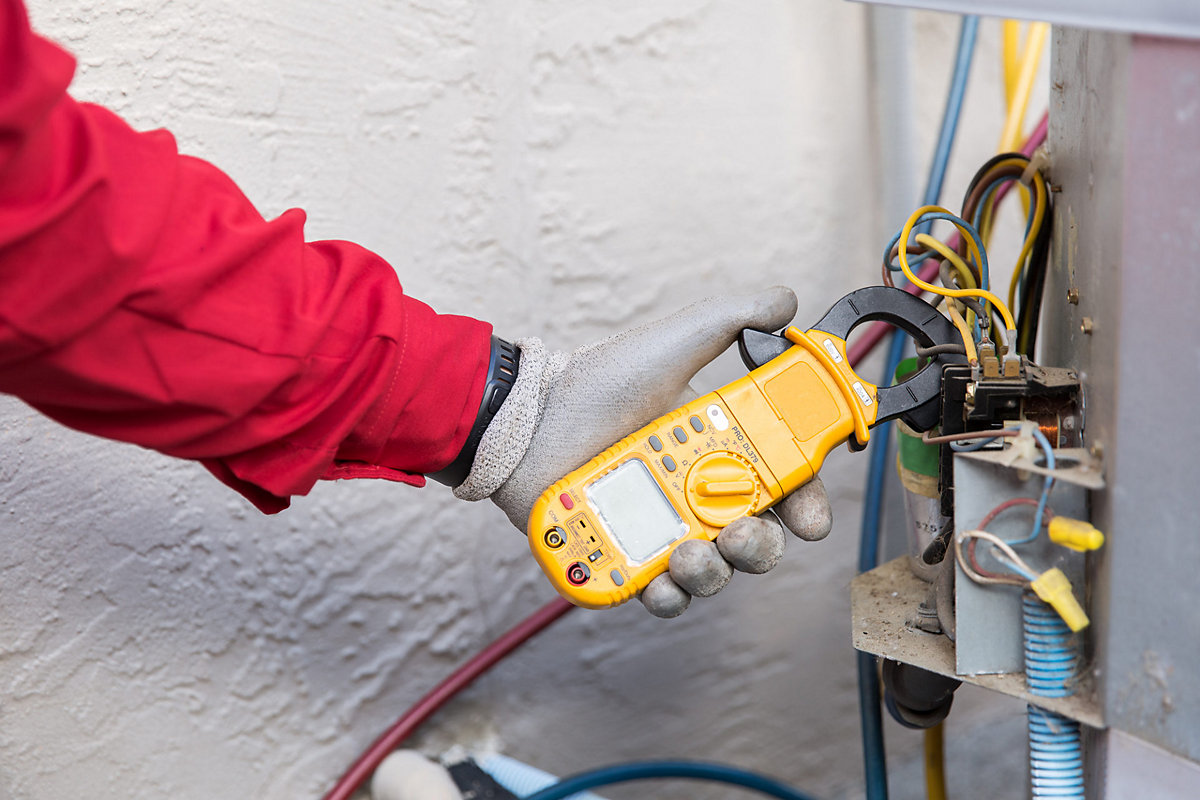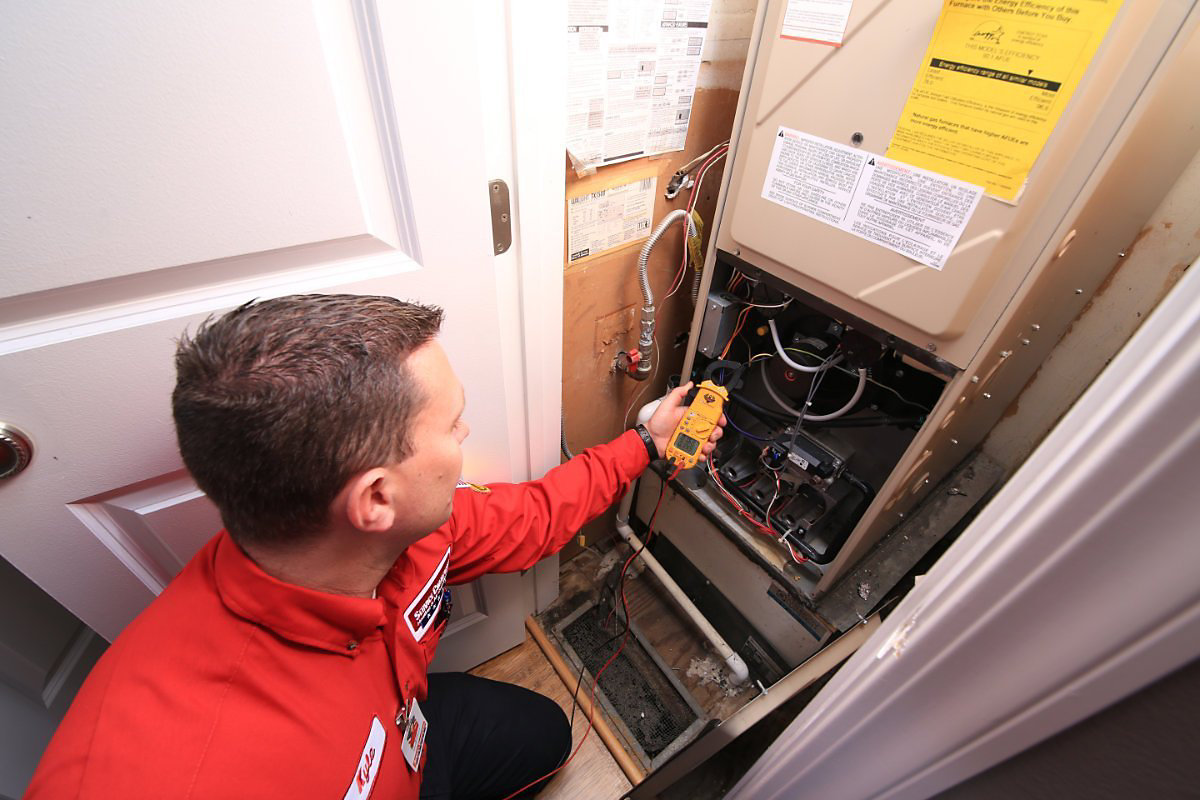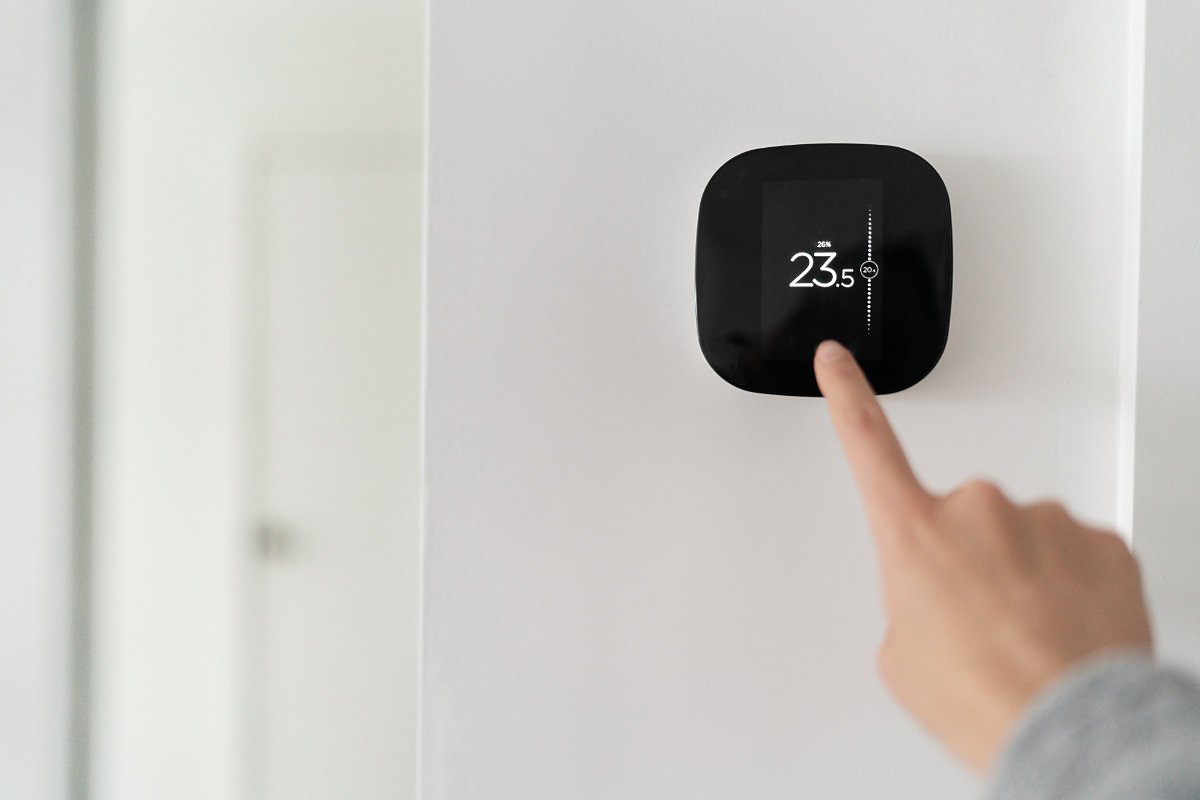Frequently Asked Questions
Here are answers to the most common questions we hear at Service Champions.
About Service Champions
No, Service Champions will not change the price. We have a ‘No Change Order’ Guarantee that means your upfront price is guaranteed to be accurate.
We have several guarantees, including this written Service Champions’ promise: If you are not 100% satisfied with the service we have provided we will refund all of your money.
To see more about all our promises, visit our Guaranteed Or It’s Free page.
The Service Champions Maintenance Value Plan (MVP) is for homeowners who want complete peace-of-mind about their air conditioning and heating systems. Regular tune-ups for both your air conditioning and furnace are included.
You’ll also get premium service, including guaranteed service response times and priority installation and discounts if you need a new unit. You even get a 20% discount on parts and a discounted rate for repairs.
There are even more benefits. To read about all of them, please visit our Service Champions MVP Program page.
Yes, all Service Champions technicians are background checked and drug-tested before being hired.
Also, for your peace of mind, all Service Champions technicians arrive in clean uniform with a picture ID, and we will provide you with a text message of who is showing up to your home. For more about our technicians, please visit our Best Technicians page.
Yes, we are. In fact, thanks to our tremendous track record of consistent client satisfaction, we just earned Diamond Certification for the 18th consecutive year.
We have the Better Business Bureau’s highest possible rating: A+.
Yes, Service Champions partners up with companies who can help you get a payment plan that fits in your monthly budget. For more information, please visit our Financing page.
We’re looking for people with a great attitude and a strong work ethic. Service Champions offers you a career with tremendous earning potential. For more details, please visit our Careers page.

Air Conditioning
Yes, a heat pump is an air conditioner that can also work in reverse to heat your home during the winter. Heat pumps are more energy efficient than furnaces, so they’re a cost efficiency heating and cooling option.
Your furnace and air conditioner’s inside unit are joined together since they share the same blower. When you air conditioner runs, the inside unit creates water through condensation. That water should be drained out of your home through a drain line.
Possible reasons why the water is pooling around the furnace include:
- Your condensate drain line is clogged with algae, mold or some other kind of debris
- There’s a hole in the drain pan.
Have a professional inspect your system to see what the problem is. Warning: Don’t ignore this problem or it will cause water damage to your home and lead to mold and mildew growth.
There are 3 signs to look for:
- Air conditioner has reached the end of it’s lifespan- An air conditioner lives 15 years on average.
- Runs inefficiently- if your system takes forever to cool your home and you have higher energy bills, it may be time to replace it.
- Requires frequent and expensive repairs- if your system needs expensive repairs every year, it would make economical sense to just get a new one
No. A ceiling fan don’t actually lower the temperature in your home; it only makes you feel cooler in the room where the fan is through the wind-chill effect. However, running your ceiling fan does allow you to turn your thermostat temperature setting up 4 degrees without feeling uncomfortable. This will help you lower your electricity bills.
First and foremost, make sure you get a programmable thermostat that’s compatible with your heating and cooling system.There are different models for different systems (straight air-conditioning, single-stage heat pumps, etc).After you know what model to get, get a programmable thermostat with the scheduling options you want:
- L5+2-day model: Least flexible model. Can set 2 temperature schedules: one for the weekdays and one for the weekend.
- 5-1-1-day model: More flexible than 5+2. Can set three temperature schedules: one for the weekdays, one for Saturday, and another for Sunday.
- 7-day-model: Most flexible model. Can set a temperature schedule for every day of the week.
You can get a general estimate of annual savings by using this tool from NATE: Annual Energy Savings Calculator
If your insulation is even with or below the attic’s floor joists, you need more insulation. The recommended amount is 10-14 inches spread evenly throughout your attic.
The type of refrigerant your air conditioner uses is probably R-22. It’s expensive because the EPA is phasing it out because it contains ozone-depleting substances. That means there’s less R-22 to go around while it’s still in high demand, causing a price rise.
There are a variety of reasons, but these are the usual causes:
- Dirty air filter
- Low refrigerant
- Dirty evaporator coils
These cause your system to freeze up on a hot day, blowing hot air as a result.
Don’t run your system like this. Your air conditioner’s compressor will eventually fail and that’s a costly repair you don’t want to deal with during the summer. If your air conditioner is blowing hot air, contact an HVAC contractor to diagnose your system’s problem and have it fixed.
Look for an air conditioner with a high SEER rating. SEER stands for Seasonal Energy Efficiency Ratio (SEER). This rating tells you the relative amount of energy the air conditioner needs to provide a specific cooling output.
The current minimum SEER rating for new air conditioners is 13. So every point over that indicates that the air conditioner is more energy efficient and therefore can lead to a lower utility bill.
This is a question we get fairly regularly during the summer. Without a comprehensive analysis of your home, it is difficult to pinpoint one specific cause of your high air conditioning bills. However, here are some of the top reasons:
- Old, unsealed home
- Insufficient attic insulation
- Leaking ductwork
- Incorrectly sized air conditioning unit
- Old cooling equipment
For more specific information on how we can help you reduce your air conditioning costs, contact us online.
Yes. Set adjust your thermostat when you are gone but do not turn it off and you can save up to $180 a year, according to ENERGY STAR. Adjust your thermostat up (in the summer) or down (in the winter) eight degrees or more when you are gone for eight hours or longer. A programmable thermostat can help you do this automatically.
Heat rises, therefore in most multi-level homes the upstairs rooms will be warmer than downstairs. However, this can be minimized with a properly balanced duct design and/or a zoning system. It could also be that your air conditioner or heater is sized incorrectly. For the most accurate diagnosis, you should have a licensed, professional HVAC contractor inspect your home.

Air Quality
During fire season, smoke can spread for miles and that smoke has particles and soot that can make your home smell and create air quality issues inside your home.
Service Champions can help solve these issues by installing an Air Scrubber to help remove contaminants and control odors. We also can clean your air ducts, your heating and air conditioning units and change your filters.
Preventing all outdoor contaminants from entering your home is not possible. A better solution is to install an Air Scrubber. An Air Scrubber will reduce approximately 90% of airborne contaminants and 99.9% of all surface contaminants. For more information, visit our Air Quality page.
Many times you can tell when you or other family members have symptoms like: headaches, congestion, coughing, eye irritation, sneezing, and nosebleeds. It’s important to note if these symptoms are more noticeable soon after entering your home. That’s a sign that poor indoor air quality is a likely cause.
Other things to take note of that could indicate poor indoor air quality include buildup of dust on and around vents, mold issues, and indoor odor problems.
If your family is experiencing symptoms of poor indoor air quality, or you have problems with indoor odors (including pet-related odors), you’re a good candidate for an Air Scrubber.
An air scrubber is composed of a broad-spectrum high intensity UVX lamp, super oxide ions, hydro-peroxides and purifying plasma. It is different than a simple air filtration system. Through advanced technology, it emits safe oxidizers that attach themselves to harmful particles and neutralizes them.
Yes, they are bad for you. It might be tempting to fill your home with festive scents, like gingerbread, through these air fresheners. But many contain:
Volatile organic compounds (VOCs)- High concentration of these cause respiratory tract infection, headaches, dizziness and memory impairment. They also “trigger allergy symptoms, aggravate existing allergies and worsen asthma,“ according to Stanley Fineman, MD, American College of Allergy, Asthma and Immunology (ACAAI) president-elect.
Phthalates– These aggravate asthma and allergic symptoms and are found in many common air fresheners, according to the “Hidden Hazards of Air Fresheners” study by the National Resources Defense Council (NRDC).
There are a few signs of air duct leaks in your home. Ask yourself if you have:
- Rooms that are hard to heat or cool.
- Dusty rooms after turning on your air conditioner.
- Higher utility bills.
- Poor air quality.
If you’ve noticed all of the above in your home, your air ducts may need to be sealed by a professional. Leaving them alone will not only cost you more money, but negatively affect you and your family’s health as well.
Like everything else in your home, your air ducts collect dust and debris over time. And while you sweep, vacuum and dust the rest of your house, the build-up in your ducts only increases.
If you have access from a register or vent in your home, you can take a peek in your air ducts to see if they could use a cleaning. Some other symptoms of dirty ducts in need of a cleaning include:
- Excessive dust in your home, even after you just cleaned it.
- Noticeable odors when you turn on your heating and cooling system
- Your air filters get dirty extremely quickly
- Mold or rodent infestation
- Visible dust coming from your vents
Your heating and air conditioning system naturally creates condensation. If this moisture is left unchecked within your ducts and HVAC system, it can create a perfect breeding ground for mold, mildew, bacteria and fungi.
A UV germicidal lamp is installed within your existing system where such contaminants are most likely to grow. The UV light neutralizes these pollutants and keeps them from spreading throughout your ducts and home.
Changing your HVAC system’s air filter is one of the easiest and cheapest things you can do to keep it running correctly. We highly recommend that you check your air filter at least once a month (or every 30 days).
Clean or replace your air filter whenever it is visibly dirty. A dirty air filter restricts airflow to your air conditioner and heater, resulting in higher energy costs, more repairs and a shorter system lifespan.
It has been known for awhile that air pollution affects your health. In fact, those subject to air pollution are at greater risk for strokes, heart attacks, respiratory complications and cardiovascular disease.
That is one of the main reasons the government has worked with businesses and local authorities to govern and limit air pollution. However, according to the Environmental Protection Agency (EPA) the air quality in your home could be up to 100 times worse than the worst outdoor air.
You should be concerned with your home’s indoor air quality because it can play an important role in the health of you and your family.
If you have a gas furnace, stove, water heater or fireplace, you need to protect yourself and your family from this deadly colorless and odorless gas. Carbon monoxide is a byproduct of incomplete combustion, so any homes with gas appliances should have a working carbon monoxide detector.
Also, you should get annual water heater and furnace tune-ups to make sure they are functioning safely. Even small issues can lead to higher than healthy carbon monoxide levels.

Heating
If it takes several seconds or even minutes for your furnace to ignite after you’ve called for heat from the thermostat, the burners are probably dirty. Dirty burners prevent the gas feeding into the furnace from igniting right away. So it builds up. When all the built up gas ignites it causses the loud bang you’re hearing.
Don’t ignore this! It can lead to cracks in the heat exchanger, which costs hundreds to replace.
Call a professional to come clean the burners. If the burners are that dirty, then the rest of the furnace probably needs professional maintenance as well. We offer an inexpensive $88 furnace maintenance visit.
Yes. A ceiling fan running in “reverse” (which is typically counterclockwise) takes the rising hot air and pushes it back down throughout the edges of the room, helping you keep warm.
There are several possible causes:
- Thermostat’s fan setting is set to “ON” instead of “AUTO”
- Pilot light went out because of a strong draft, a dirty pilot, or a bad thermocouple (safety device)
- No gas going to the furnace. Make sure the gas valve switch is set to “ON” (lever is parallel with the gas line going to the furnace)
Contact a heating contractor to get a proper diagnosis.
A variable-speed furnace increases your system’s heating and cooling efficiency by running for longer periods of time.
Wait a minute. You’ll save money because your system will be running longer? That’s correct.
You see, basic furnace fans operate at either 100% or 0%. In other words, they’re like light switches: they’re either on or off. But this makes them less efficient because they must use the same amount of energy no matter how much heat or air conditioning you need.
This is like flooring the gas pedal on your car every time you take off from a traffic light. You’ll get to your next stop faster, but you’ll also use a lot more gas.
A variable-speed furnace adjusts the speed based on what is needed. So it often runs for longer periods of time but at slower speeds. This increases energy efficiency by eliminating the waste caused from frequent stops and starts.
It depends on the type of furnace you have. Here are the average life spans of different furnace types according to Consumerreports.org:
- Electric furnace- 15 years
- Gas furnaces- 18 years
- Oil furnaces- 20 years
Remember, these are averages. Your furnace’s lifespan differs based on where you live, and the brand and model as well.
And, of course, you need annual maintenance to maximize your furnace’s lifespan
A furnace’s energy efficiency is measured by it’s Annual Fuel Utilization Efficiency (AFUE) rating. This tells you what percentage of the fuel it uses actually heats your home, and how much is lost in the fuel combustion process.
So, the higher this rating, the more energy efficient the furnace.
Old furnaces are 50% to 60% efficient. This means for every dollar of fuel your furnace uses to hear your home, only $.50 to $.60 of every dollar actually heats your home. The rest is lost up the flue pipe.
Federal mandate now requires furnaces to have a minimum AFUE of 80%. But you can buy a furnace with an AFUE rating as high as 98%.
When you turned on your furnace for the first time this winter, did you notice a burning smell in your home? Don’t worry, this is pretty normal.
You see, as your heater sits unused during the summer, it collects dust. If you do not get your annual heating tune-up before you turn on your furnace, it burns off some of this dirt when it heats up. How long the smell lasts depends largely on how dusty your furnace got.
You can minimize this smell by making sure you get a heating tune-up each fall. During a tune-up, your furnace’s internal components are cleaned, which also keeps your heater running efficiently all winter.
If you are looking for a new furnace for your home, one of the first things you need to figure out is the size you need. Furnace’s heating capacities are measured in BTU’s (British Thermal Units).
You can use your old furnace as a starting point, but for the most accurate sizing, you should have a professional do a load calculation. They will take into account your home’s insulation, number of windows, floors, etc.
Yes. Like your vehicle, your furnace is a machine with moving parts. And, like your vehicle, it also requires regular maintenance. (Can you imagine what would happen to your car if you drove it without ever changing the oil?) A furnace tune-up keeps your heater running safely and efficiently all winter, reduces the repairs you will need and helps decrease your utility costs.
Yes. Set adjust your thermostat when you are gone but do not turn it off and you can save up to $180 a year, according to ENERGY STAR. Adjust your thermostat up (in the summer) or down (in the winter) eight degrees or more when you are gone for eight hours or longer. A programmable thermostat can help you do this automatically.
There are several things that could be causing water to leak from around your furnace while your air conditioner is running. The most common is a clog in your drain line or hole in the drain pan.
As your air conditioner cools your home, it creates condensation. However, this condensation should be draining out of your home. If it is not, make sure to get it fixed immediately as even a small water leak can cause damage to your home and lead to mold and mildew growth.
Cold air cannot hold as much moisture as warm air. Therefore, even though the relative humidity of the cold air outside could be high, when it is warmed by your heat pump or furnace the relative humidity drops because the air can now hold more moisture. This creates a dry, uncomfortable environment in your home in the winter.
In addition to being uncomfortable, dry air can damage your wood furniture and flooring and cause wallpaper to peel. A whole-home humidifier will increase your comfort and keep you warm all winter. And, because humid air feels warmer, you can actually cut your heating bills.

Smart Thermostats
Programmable thermostats can save you up to $180 a year if you know the right setbacks and setups that will use your heating and cooling system efficiently.
For an in depth guide on how to set a programmable thermostat, check out this programmable thermostat tips article from Energy.gov.
A programmable thermostat is a thermostat with an additional set of features that automatically adjust the temperature of your home based on the day of the week and the time.
For example, if you work Monday through Friday, 8 a.m. to 5 p.m., you can set a programmable thermostat to automatically adjust the temperature when you leave and return each day, saving you money on your energy bill.
Wi-Fi is what allows you to control the thermostat from any part of the home, and even remotely when you’re not at home.
A connected home is one that integrates all kinds of functions in your home and makes them controllable from smart devices (often your mobile phone).
This can range from anything from the lighting in your home, your entertainment systems, your heating and air-conditioning, and more. A smart thermostat is an important part of a connected home.
If you still have a more traditional thermostat, upgrading to a smart thermostat is a way to save energy and give you greater control over your indoor comfort.
It is impossible to give a one-size-fits-all answer to this. However, as a general recommendation we do encourage homeowners to upgrade to a smart thermostat because of the energy saving benefits and greater control of your home comfort.
The answer to this depends on your home and the type of air conditioning and heating system you have. For many homeowners, one thermostat is enough.
If you have a ‘zoning’ based system installed in your home (or would like one), then multiple thermostats will be needed. For more information about this, please visit our Zoning page.
You want to avoid putting a thermostat on any place in your home that is subject to more extreme temperatures. Avoid outer walls, or rooms that typically get warmer or cooler than the rest of your home.
Contact us 24/7!
ZERO CONTACT SERVICE. PUTTING SAFETY FIRST.
Service Champions is committed to maintaining a safe and healthy environment for our clients and team members.
It is important for you to feel confident when our technicians are arriving at your home.
We have implemented increased hygiene routines, including hand washing and sanitizing before and after each client visit.
Additionally, our technicians are avoiding typical contact with our clients, like shaking hands.
Every Service Champions team member in your home will be equipped with the following:
-
Shoe Covers
-
Face Masks
-
Antibacterial Soap
-
Disposable Latex Gloves
-
Disinfecting Wipes
We will remain open full-time to service and maintain our clients’ heating, air conditioning and indoor air quality needs 7 days a week.
Certified to be the best







